The Department of Science and Technology (DOST), together with BioAssets Corporation, leveraged science, technology, and innovation (STI) to develop three technologies to detect and manage African Swine Fever virus (ASFV).
ASFV, a causative agent of hemorrhagic fever in pigs, has continuously devastated the swine industry. In the Philippines, ASF outbreaks have occurred in 76 out of 82 provinces since 2019, with six provinces having active cases as of July 11, 2025.
Responding to the need for a rapid detection of the virus, the DOST-Industrial Technology Development Institute (DOST-ITDI) developed two technologies that use a rapid, accurate, and real-time Polymerase Chain Reaction (PCR) protocol applicable for point-of-need detection of ASFV. PCR is a laboratory technique used for amplifying multiple copies of a target DNA segment from a sample. It involves single-stranded DNA fragments called primers that complement the target DNA segment for multiple gene amplification.
These two developed technologies to detect ASFV are “TUSLOB® Rapid DNA Extraction Kit” and “VIPtec® African Swine Fever Virus (ASFV) Real-time PCR Detection Kit.” These two detection kits are meant to be used subsequently. The project is under the Virology and Vaccine Research Program (VRP) funded by DOST and monitored by the DOST-Philippine Council for Agriculture, Aquatic and Natural Resources Research and Development (DOST-PCAARRD).

(Image credit: BioAssets Corporation)
The third technology is the first Filipino-made “Mobile Biocontainment Laboratory (MBL)” developed by BioAssets Corporation. MBL was intended to support rapid response to potential outbreaks and improve capacity building and disease surveillance that would enable farmers and veterinarians to craft mitigation strategies, preventive and control measures at the point-of-need.
“As a government agency committed to advancing STI, DOST has continuously backed research initiatives focusing on diagnostics and vaccine development for animal infectious diseases such as ASF,” said DOST Secretary Renato U. Solidum, Jr. “These three technologies delve into the potential of STI to address critical issues in animal health, especially regarding ASF. These highlight how STI can contribute holistic solutions to pressing animal health challenges that impact our food security.”
Developed detection kits

To enable fast and reliable diagnostics, the TUSLOB® Rapid DNA Extraction Kit was optimized for point-of-care (POC) testing, which makes DNA extraction easier in veterinary and agricultural settings. It can also be used for further detection of other diseases in animals. This user-friendly innovation was designed to produce quality DNA extractions suitable for quantitative PCR (qPCR). qPCR is an effective molecular technique for pathogen detection that allows real-time detection and quantification of target DNA sequences during the amplification process.
Together with TUSLOB® Rapid DNA Extraction Kit, the VIPtec® ASFV Real-time PCR Detection Kit is optimized for use with portable and cost-effective qPCR machines, making it highly suitable for early and on-site diagnosis of ASFV in areas where a conventional disease diagnostic laboratory is unavailable or limited. This enhances its practicality for veterinarians and animal health workers conducting field investigations and diagnosis, reducing virus transmission and potential economic losses. Compared to traditional qPCR systems, VIPtec® requires less complex materials for detection, making it an efficient and cost-effective equipment for field applications. Additionally, its real-time and reliable results provide practicality in areas with limited access to traditional systems.
Initial validations of TUSLOB® and VIPtec®

The project team conducted internal as well as external validations in coordination with various Department of Agriculture-Regional Animal Disease Diagnostic Laboratory (DA-RADDL). The validations compared the results of TUSLOB® paired with VIPtec® to those of commercial detection kits.
Following further optimization, TUSLOB® with VIPtec® was seen as comparable to commercial detection kits. This was determined during a demonstration and testing conducted in the College of Veterinary Medicine of the University of the Philippines Los Baños (CVM-UPLB) and DA-RADDL Region IV-A.
TUSLOB® extraction analysis with a commercial kit also showed consistent results, as demonstrated in DA-RADDL Regions II and VI. The external validation demonstrates the strong potential of VIPtec® paired with TUSLOB® for point-of-need detection of ASFV.
Ways forward
The results of the optimized ASFV detection kits were presented and promoted during scientific meetings and exhibits. The training and interaction with industry stakeholders helped the project team align the project’s key findings to the needs of their beneficiaries.
Moving forward, the project aims to produce more of the detection kits once field validations are completed (Ginia Felice C. Garcia, Ma. Czarina R. Moreno, DOST-PCAARRD S&T Media Services).

